Dell Latitude E6410: Minding Intel's Business
by Jarred Walton on December 2, 2010 2:45 AM ESTLCD: Matte but Mediocre
Back to a look specifically at the E6410, here's how the LCD panel rates. We like the resolution, we like the maximum brightness, but the contrast rates near the bottom of our charts and as a result the colors look washed out. Matte doesn't have to be low contrast (i.e. the MacBook Pro 15 has a good matte panel), but apparently high quality LCDs are only needed in mobile workstations, MacBook Pros, and a few select other laptops (including the XPS 15's 1080p panel).
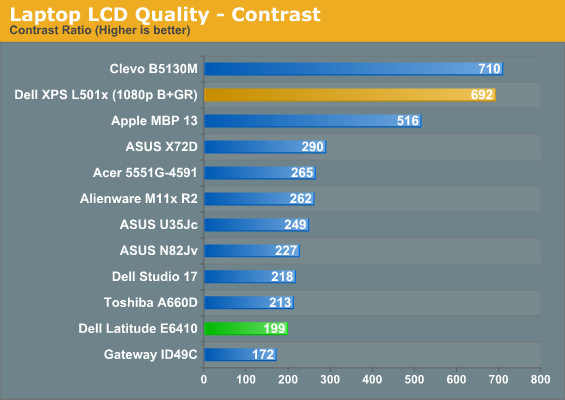

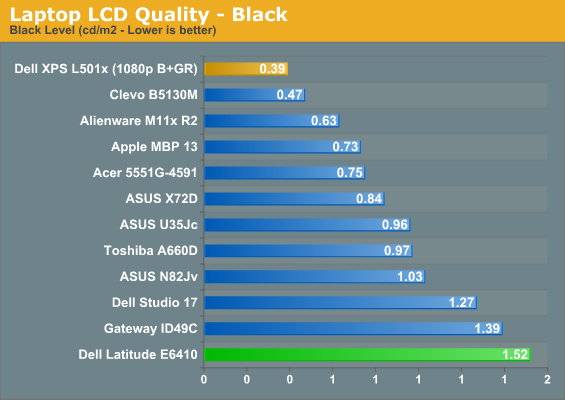
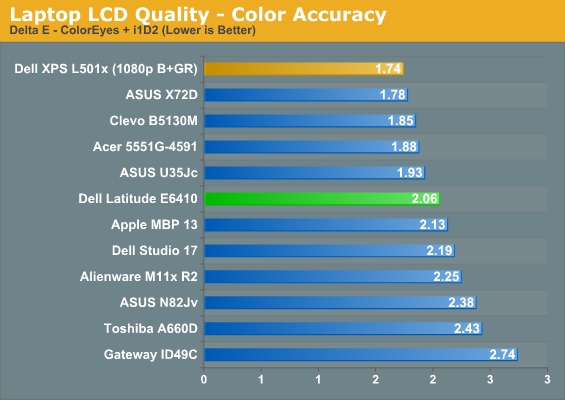
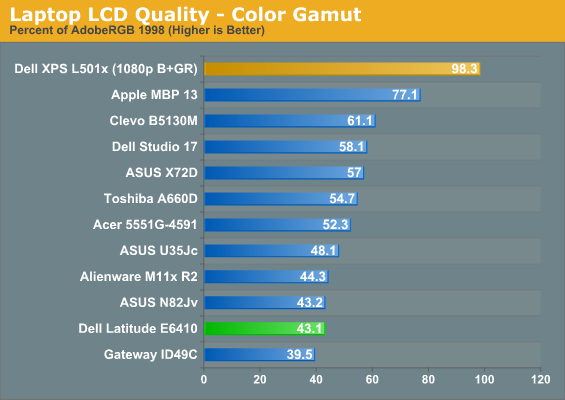
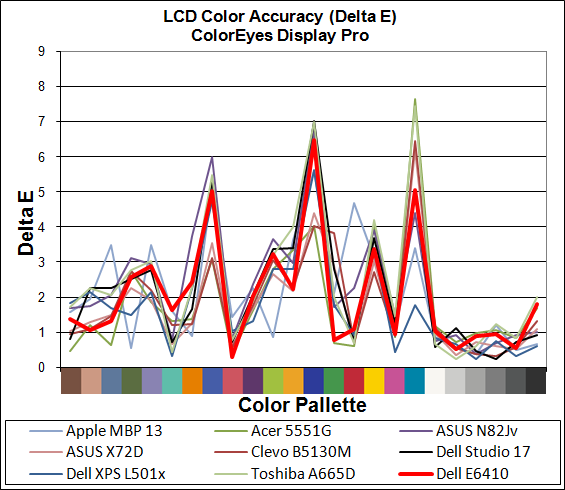
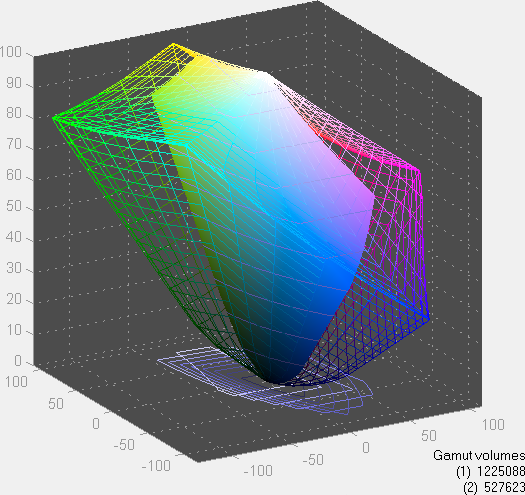
Temperatures and Noise
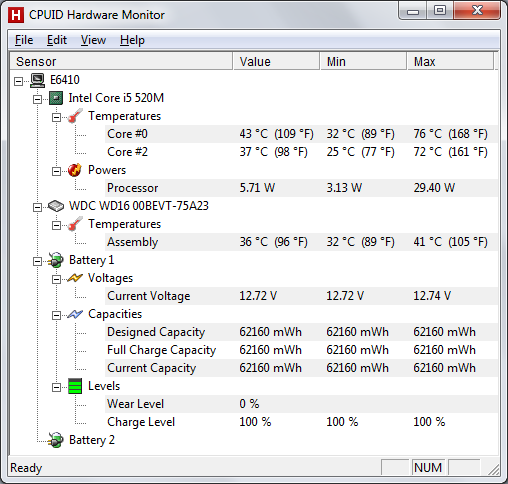
There's not a whole lot to say in regards to temperatures and noise. With only integrated graphics, the E6410 doesn't get particularly hot or loud. The CPU temperatures under load reached a maximum of 76C, and noise levels ranged from 30dB at 12" (the limit of my SPL meter) at idle and light loads to as much as 34dB with a maximum load on the CPU and GPU. In other words, if you were to use the E6410 in a meeting, your typing would be far more obnoxious than the noise from the fan.
















51 Comments
View All Comments
SandmanWN - Thursday, December 2, 2010 - link
Even though it is a matte surface on these instead of gloss. It still show finger prints almost as readily as a gloss finish.SandmanWN - Thursday, December 2, 2010 - link
On the casing, not the monitor.JarredWalton - Thursday, December 2, 2010 - link
Well, it depends on your point of reference. The glossy black (or glossy dark) laptops are horrible. Neutral grey/silver will inherently hide a lot of fingerprints, and white laptops do so even more. But you won't be free from fingerprints just by getting a matte finish; they're just not quite so apparent.mino - Thursday, December 2, 2010 - link
No fingertips for your eyes or police to sneeze at. :Dmino - Thursday, December 2, 2010 - link
One thing make me a little puzzled:"~20% with the same number of cores at the same clock speed"
Across-the-board? Are you sure about that cause it sure sound like PR spin.
Cause 20% is in the ball park of Merom -> Arrandale!
IMO it is a feat that SB will be hard-pressed to get even remotely close to.
Than kind of boost was NOT achieved since P4-M -> Banias switch.
10%, maybe approaching 15%, that sounds feasible though.
JarredWalton - Thursday, December 2, 2010 - link
Not sure if you've looked at the SB preview and architecture articles, but I'd say 20% is probably reasonable as an average. Some benchmarks/apps will be even faster, but there will also be those that don't benefit a lot. Here's Anand's look at the SB architecture, which explains where the performance improvements come from:http://www.anandtech.com/show/3922/intels-sandy-br...
I guess we'll just have to wait for hardware to see how much it actually performs. Maybe most of the increase will come from higher Turbo modes? But there are enough changes to the entire package that we should see some pretty decent performance boosts.
dell169 - Thursday, December 2, 2010 - link
"I also appreciate the move back to an old-style 16:10 aspect ratio, though I still prefer the 1080p LCD in the Studio XPS 16 over WXGA+"Hold on to it, its the last one. All latitudes will go to 16:9.
You may not have noticed, but the E6510 (same as E6410, but 15.6" screen) has 16:9 with 1920x1080 as highest resolution. This is really annoying, +5 year old latitudes have better resolution than that ! (1920x1200)
For business vertical resolution is absolutely more useful than horizontal and I expect a business line, for which you pay a considerable premium, would consider that.
The only thing 16:9 is better for is wide-screen TV programs so you don't have some black bars on the top and bottom of the screen. It is not even better for movies because those are 2.35:1 (~21:9) so there will be black bars anyway.
JarredWalton - Thursday, December 2, 2010 - link
AFAICT, it's not Dell and the laptop people driving the move to 16:9. I could be mistaken, but it appears to be primarily a push by the LCD panel makers so they can increase the number of panels they get from a glass substrate (and thus increase profit margins). Maybe the LCD manufacturers are happy with the move as well, but the only alternative appears to be paying a significant price premium to get a customized LCD. Sony has done that with their VAIO Z; no one else uses a 13.1" LCD at least, and certainly not a 900p panel in that size. But then you look at the VAIO Z cost and wonder if it's worth doing. :-\dell169 - Thursday, December 2, 2010 - link
Nobody is driving this move to 16:9. The problem is that nobody is driving anything. This whole move from 19:10 to 16:9 is happening because of customer ignorance and vendor fear.The customer would probably prefer 16:10 but most are not even aware of the issue and do not know much at all about computers, so price is usually the strongest motivator for them.
Vendors are afraid to use the little more expensive 16:10 screens because of the above and therefor switch to 16:9. Initially for the consumer models, but this results in less demand for 16:10 screens. They get more expensive, harder to get, the price difference increases and vendors are even more inclined to switch to 16:9
result: a race to the bottom of the barrel and soon we can only get portables with 16:9 screens while most people really would like to have a 16:10 screen for a few measly dollars more (whether they know it themselves or not, there were good reasons to choose 16:10 over 16:9 when the move was made from 5:4.)
I can understand vendors going along with this for the sake of their bottom line, but I do not understand why they do this for their business lines which are about 2x the price of the average consumer laptop anyway. I mean, people for whom price is the strongest motivator are not your target anyway.
mike8675309 - Friday, December 3, 2010 - link
Dell and all the other laptop companies need to push their vendors to perform better. As is pointed out time and time again by this site, these companies are simply not providing high quality displays on these laptops, regardless of the resolution.These companies seem bent on commoditizing their products with no one willing to put out a best product at a reasonable price. Everyone seems satisfied providing a sufficient product.